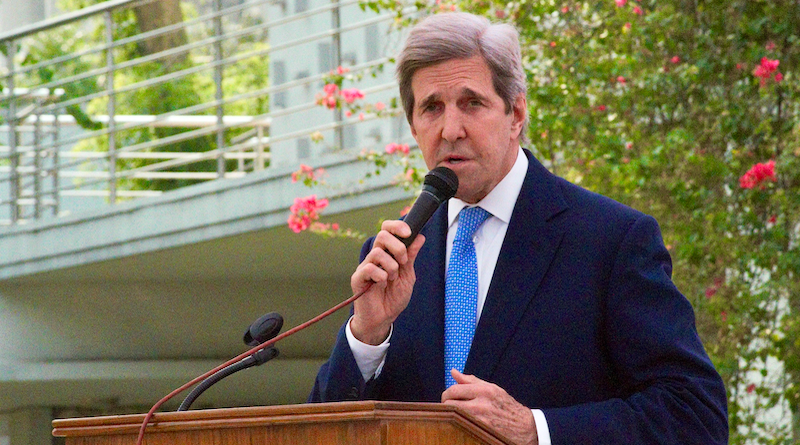Climatic Hustle: The Complicated Partnership Of US-China In Addressing Climate Change – OpEd
During a three-day visit to China, US special envoy on climate change, John Kerry, classify the Climate Change as a “universal threat to humanity” a response also reflected by his Chinese equivalent, Xie Zhenhua. As these two economic giants, also the world’s largest pollution creators struggle with the pressing issue of climate change, which analytically should be a common goal, the reality defines a different story. Climate diplomacy, when intertwist with the historical complexities of china and America’s relations, bares a complex dynamic between these two economic giants that consequently influences every aspect of international relations – including the climate change.
Focusing some of the recent occurrence when both of the states tried to make progress, and how this fell apart, is useful. The major improvement came when the United States and China joined hands at COP26 for climate cooperation talks intervening political tensions. In an innovative moment, both countries issued a joint declaration acknowledging the insistence of combating climate change and guarantee to intensify their efforts. China’s best climate diplomat, Xie Zhenhua, emphasized the common ground between the nations, stating, “There is more agreement between the two countries than the divergence.” Xie’s statement was followed by John Kerry’s, who, while acknowledging the differences, recognized, “on Climate, cooperation is the only way to get the job done”. However, this success was short-lived.
Further tensions between both of countries increased when Nancy Pelosi visited to Taiwan. The ensuing situation essentially brought both countries at loggerheads that resulted in the suspension of all sorts of cooperation, including climate change. Beijing’s response to severing the climate cooperation was straightforward, claiming that no aspect of the bilateral relationship can be isolated from the broader political ties. Chinese diplomat Wang Yi briefly captured this opinion, affirms that “climate cannot be an oasis surrounded by the desert.” The relationship was give out with another blow in February 2023 when a Chinese espionage airship was shot down over American airspace, prodding the Secretary of State Antony Blinken to cancel his planned visit to China.
The escalation of tensions between both countries, reduces the spaces of climate cooperation. President Biden’s signature “Inflation Reduction Act” approved in August 2022, raised eyebrows in China as it was seen as a strategy to cushion the US domestic renewables industry at the expense of Chinese productions. This perception regarding each other further strained the diplomatic ties, leaving the climate partnership on ice. With progress hampered on the diplomatic front, the Biden administration sought all-possible ways to press China into reducing outrushes, indicating it might place further “carbon footprint-linked tariffs” on Chinese imports. This move was named by the Chinese policymakers as “green trade barriers,” aimed at weakening the competitiveness of Chinese exports in international markets. Kelly Sims Gallagher, who served as a senior adviser on Chinese climate matters in the Obama administration, gives a synopsis of China’s perspective by stating: “Climate is understood by China to be something the U.S. wants, and it’s using climate as a source of leverage in the multifaceted relationship.”
As the world’s two biggest economic powers involve in such disputes, developing countries that are struggling with the effect of “climate crisis” have intensified their demands. They are demanding that the wealthier developed North fulfill their promises to provide $100 billion each year to help with the climate action. In the past, both the United States and China have acknowledged their responsibilities to unfortified developing nations. However, their actions have often dishonored well short.
During the Obama presidency, the US guaranteed $3 billion to the Green Climate Fund, the largest climate fund which provides funding for climate initiatives in developing countries. However, it failed to deliver on $2 billion of that promise, primarily because of the succeeding Donald Trump administration’s decision to withdraw from the Paris climate accord (Biden later rejoined).
In 2015 Same China committed $3.1 billion to set up what it called a “South-South” climate cooperation. However, the narrative of this initiative is also not quite different from that of its counterpart, having delivered only about 10 percent or $310 million of the initially promised $3.1 billion funding.
There is an old African proverb “when elephants fight, it is the grass that suffers” sits rather aptly in this context as it is poorer, more climate-vulnerable, nations that are suffering in the US-China pursuit of world dominance. As the climate challenge continues to grow year-on-year, the spotlight remains overly fixed on how these two superpowers navigate the intricate path of climate cooperation while safeguarding their respective national interests.

